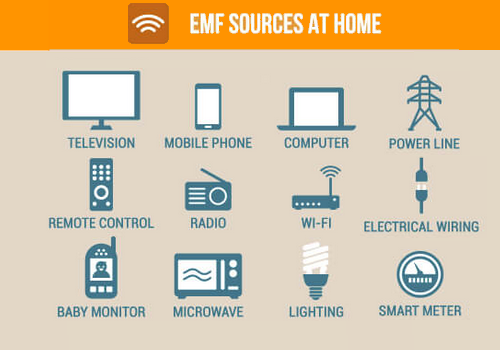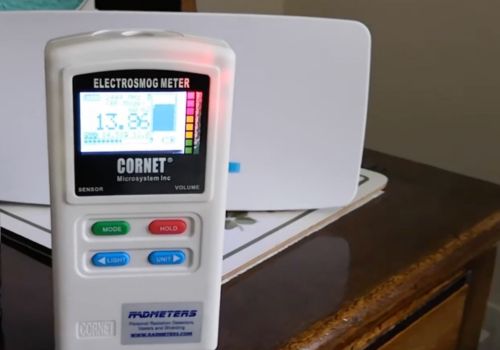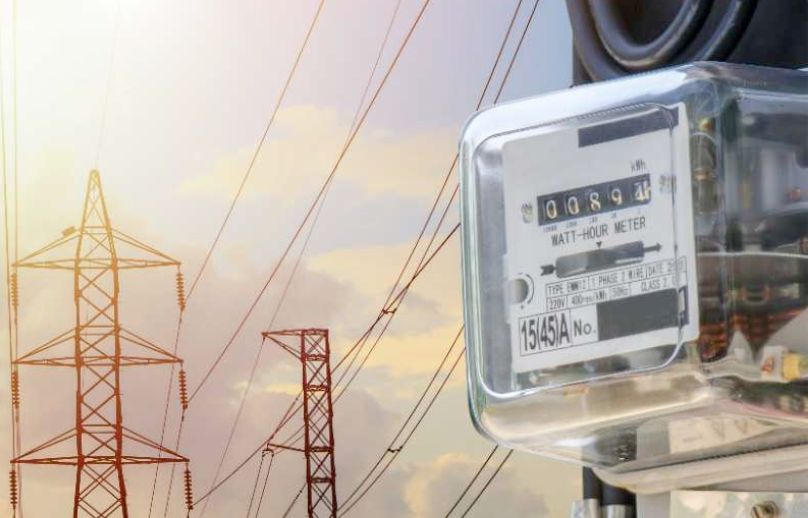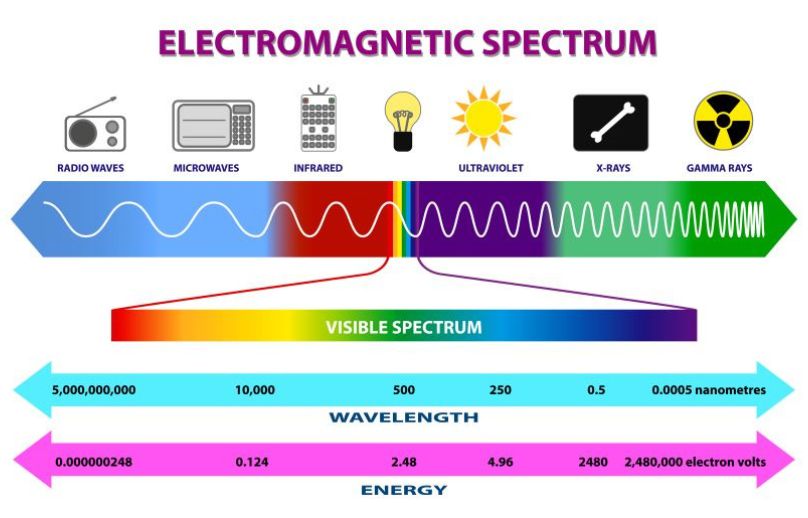Electromagnetic fields (EMFs) are present in both natural and human-made forms throughout our homes. This guide will help you identify common EMF sources, understand how to measure them, and explore practical strategies for reducing exposure where desired.
The key to managing EMF exposure isn’t about eliminating all sources, but rather about making informed choices about which sources matter most to you and understanding the most effective ways to reduce exposure from those sources.
Whether you’re looking to create a lower-EMF sleeping area or better understand your environment, you’ll find the knowledge and strategies you need here.

Start By Measuring Where You Spend The Most Time
When assessing EMF exposure in your home, focus first on areas where you spend significant time, particularly:
- Sleeping Areas: The average person spends 6-8 hours in bed, making bedroom EMF levels especially important
- Work Spaces: Home offices or areas where you spend long hours at a desk
- Living Areas: Common spaces where family members gather for extended periods
- Children’s Rooms: Areas where children sleep, play, or study
- Kitchen: While exposure time may be shorter, EMF levels can be higher due to multiple appliances
Recommended EMF Meters
For those serious about measuring EMFs in their home, I highly recommend the GQ-390 EMF meter. It’s my top choice because it combines three essential measurement functions in one device – measuring magnetic fields, electric fields, and RF radiation simultaneously.
What sets it apart is its user-friendly interface that displays all three readings on the screen at once, eliminating the need to switch between modes. One of its most helpful features is the automatic source identification, which can help you identify common EMF sources without needing to be an expert.
Common EMF Sources Throughout Your Home
EMF sources can be found throughout your home in everything from major appliances to small electronic devices. Understanding where these sources are located can help you make informed decisions about device placement and usage.
The following covers the most common EMF sources you’re likely to encounter in a typical home environment.
1. Power Infrastructure
- External power lines
- Electrical panels and sub-panels
- Solar power inverters
- Electric vehicle charging stations
- Ground current issues
- Wiring in walls
- Circuit breaker boxes
- Power meters (especially smart meters)
2. Major Appliances
- Electric stoves and ovens
- Refrigerators
- Dishwashers
- Washing machines
- Clothes dryers
- HVAC systems
- Water heaters
- Pool pumps and equipment
3. Kitchen & Small Appliances
- Microwave ovens
- Coffee makers
- Toasters and toaster ovens
- Blenders and food processors
- Electric kettles
- Stand mixers
- Instant pots/electric pressure cookers
- Small refrigerators
4. Entertainment & Office Equipment
- Televisions
- Computer monitors
- Desktop computers
- Laptops and tablets
- Gaming consoles
- Stereo systems
- Printers and scanners
- Computer peripherals (wireless keyboards, mice)
- Bluetooth speakers
- USB hubs and chargers
5. Lighting Systems
- Fluorescent lights
- LED bulbs and fixtures
- Dimmer switches
- Smart bulbs
- Under-cabinet lighting
- Track lighting
- Motion sensors
- Light timers
6. Wireless & Communication Devices
- Wi-Fi routers
- Mobile phones
- Cordless phone base stations
- Baby monitors
- Bluetooth devices
- Wireless speakers
- Smart watches
- Tablets and e-readers
7. Personal Care & Health Devices
- Electric toothbrushes
- Hair dryers
- Electric shavers
- CPAP machines
- Electric blankets
- Heating pads
- Massage devices
- Air purifiers
8. Smart Home & Security
- Security cameras
- Doorbell cameras
- Smart thermostats
- Smart speakers
- Motion sensors
- Automated blinds
- Smart appliance hubs
- Environmental sensors
9. Outdoor & Garage
- Electric yard tools
- Power tools
- Garage door openers
- Security lighting
- Electric car chargers
- Well pumps
- Electric fences
- Outdoor lighting systems
Understanding EMF Types
EMFs exist in several forms:
- Electric Fields (measured in V/m)
- Created by voltage in electrical devices
- Easily blocked by many building materials
- Strength decreases with distance from source
- Magnetic Fields (measured in mG)
- Created by current flow
- More difficult to block than electric fields
- Strength decreases rapidly with distance
- Radio Frequency Radiation (measured in µW/m²)
- Created by wireless communications
- Can pass through walls but weakens with distance and obstacles
- Dirty Electricity (measured in GS units)
- Caused by interruptions and spikes in electrical current
- Created by devices that interrupt current flow (dimmer switches, variable speed motors, solar inverters)
- Travels through home wiring
- Can be conducted and radiated into living spaces
What Are Safe Levels
The Building Biology guidelines recommend these levels, especially for sleeping areas:
- RF radiation: < 10 µW/m²
- Electric fields: < 1 V/m
- Magnetic fields: < 0.2 mG
Note that these are conservative guidelines, and typical urban environments often have higher background levels.
Understanding Relative EMF Strength
While exact EMF levels vary by specific device and situation, these general patterns of relative strength can help guide your attention:
Typically Higher-Emitting Sources
- Microwave ovens (when operating)
- Electric stoves and ovens
- Large motors (HVAC, pool pumps)
- Electric clothes dryers
- External power lines
- Electrical panels
- Solar power inverters
- Electric vehicle chargers
Typically Medium-Emitting Sources
- Refrigerators
- Dishwashers
- Desktop computers
- Computer monitors
- Wi-Fi routers
- Smart meters
- Hair dryers
- Electric heaters
Typically Lower-Emitting Sources
- LED lighting
- Phone chargers
- Small kitchen appliances when not in use
- Clock radios
- USB hubs
- Smart thermostats
- Most battery-powered devices
- Well-maintained electrical wiring
Important Note on Source Variability
- Low doesn’t necessarily mean safe
- Individual devices of the same type can emit very different levels
- Malfunctioning devices may emit much higher levels than typical
- Some seemingly “minor” sources can be surprisingly strong emitters
- Age, maintenance, and usage patterns can all affect emission levels
- The same device might emit different types of EMFs at different levels
- Combined sources can create unexpected hot spots
- Distance and placement significantly affect exposure levels
Measurement Principles
Understanding how to properly measure EMF levels is essential for accurately assessing your exposure and verifying the effectiveness of reduction strategies.
The following factors can significantly impact EMF measurements and should be considered when evaluating levels in your home.
Key Factors Affecting EMF Levels
- Distance
- EMF strength typically decreases significantly with distance
- This is the most reliable way to reduce exposure
- Even small increases in distance can make a big difference
- Usage Patterns
- Many devices only emit strong fields during active use
- Some devices have standby emissions
- Consider both peak and continuous exposure
- Device Condition
- Older or malfunctioning devices may emit stronger fields
- Damaged power cords can create stronger fields
- Regular maintenance may help reduce emissions
Measurement Challenges
When measuring EMFs in your home, several factors can affect the accuracy and reliability of your readings. Being aware of these common challenges helps you obtain more accurate measurements and better interpret your results.
- Equipment Limitations
- Consumer meters vary in accuracy
- Different meters for different field types
- Results can vary between devices
- Environmental Factors
- Building materials affect readings
- Metal objects can concentrate fields
- Other sources can interfere
- Time of day affects readings
- Measurement Technique
- Hold meter correctly
- Take readings from multiple angles
- Record both peak and average readings
- Document measurement conditions
EMF Reduction Strategies
While eliminating all EMF exposure isn’t practical in modern homes, there are many effective ways to reduce your exposure to EMF sources. The following proven strategies can help you minimize EMF levels, particularly in areas where you spend the most time.
Proven Approaches
- Distance
- Move furniture away from sources
- Rearrange workspaces
- Relocate charging stations
- Consider sleeping area arrangement
- Usage Modification
- Turn off unused devices
- Reduce usage duration
- Use devices at lower settings
- Schedule usage appropriately
- Source Reduction
- Eliminate unnecessary devices
- Replace higher-EMF items
- Choose lower-EMF alternatives
- Consider non-electric options
EMF Protection Products
When considering EMF protection products, focus on solutions that address specific sources and have measurable effects. Here are some of my favorite items.
Air Tube Headphones
Air tube headphones reduce EMF exposure by replacing traditional wire speakers with hollow air tubes that conduct sound. This keeps the EMF-emitting components further from your head while still providing clear audio. They’re particularly beneficial for people who spend long hours on phone calls or listening to music. Go to my recommended air tube headphones page here.
JRS Eco Wireless Router
This innovative router offers several key EMF reduction features:
- Reduces beacon frequency by 90%
- Automatically switches to zero radiation mode when not in use
- Seamlessly reactivates when you turn on your device’s WiFi
- Maintains full functionality while reducing exposure. To Learn more read my JRS Eco Router review here.
EMF Protection for Sleeping Areas
Several options are available for reducing EMF exposure while sleeping:
- Grounding bed sheets: Connect to the earth’s natural electrical field. Go to my recommended grounding sheets page.
- EMF bed canopies: Shield from RF radiation from multiple directions. Go to my recommended bed canopies page.
- Consider testing effectiveness with an EMF meter
Smart Meter Guards
These shields help reduce RF radiation from smart utility meters while allowing them to function normally. Installation is straightforward and doesn’t interfere with meter operation. Go to my recommended smart meter guards page.
Dirty Electricity Filters
These devices plug into your outlets to help reduce high-frequency voltage transients on your home’s electrical wiring. Most effective when used as a whole-house solution. Go to my recommended dirty electricity filters page.
Low EMF Baby Monitors
For parents concerned about EMF exposure, low EMF baby monitors offer:
- Reduced transmission power
- Voice activation features to minimize continuous transmission
- Some models use different technologies than traditional monitors. Go to my recommended low EMF baby monitors page.
Important Considerations:
- Verify effectiveness with EMF measurements before and after installation
- Focus on products with clear, specific claims and return policies
- Proper installation is crucial for effectiveness
- No product blocks all EMFs completely
- Some can increase EMF if not used properly
- Distance and reducing usage remain the most reliable strategies
Conclusion
Understanding and managing EMF exposure requires:
- Awareness of common sources and their typical relative strength
- Recognition that sources can vary significantly
- Regular monitoring of key areas
- Practical reduction strategies
- Focus on highest-exposure areas
Remember that distance is your best tool for EMF reduction, focus on areas where you spend most time, and prioritize necessary vs. optional exposures. Take measurements to verify changes and consider the cumulative effect of multiple sources in the same area.
References
https://pennaelectric.com/emf-protection-6-steps-you-can-take-for-you-your-family/




